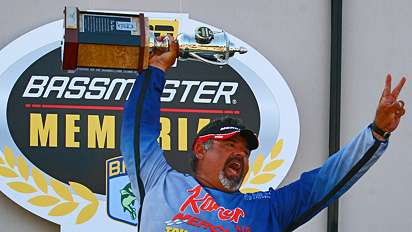
It took just a few hours, a little while in the overall week of practice a preparation for the Bassmaster Memorial presented by Evan Williams Bourbon.
Peter Thliveros figured taking a short jaunt around Onondaga Lake might pay off. If nothing else, even if he was prohibited from making a cast, he could look at the water, look at the shore, watch his sonar unit to see what was under the surface.
Compare it to a baseball player taking a few extra whacks in the batting cage or a basketball player going out after practice to work on his free throws. Maybe a golfer hitting an extra 50 balls from the bunker, just to work on the grip.
That wouldn't be a completely accurate comparison, though, because Thliveros could only do half of what he does best, which is fish. He could scout, but not scout completely. Practice, but not get the full gist by tossing a lure.
But that didn't matter.
What Thliveros did last Wednesday for a few hours paid off Sunday when he won the tournament by two ounces over Steve Kennedy of Alabama. Thliveros won the 2006 Memorial, too, making him the only two-time winner in the Bassmaster Majors series that will end after next month's Legends tournament in Arkansas.
So in that short practice time last week, what did Thliveros look for or see that made the difference?
"Anything irregular, anything different," Thliveros said. "I wanted to see what the lake had to offer and what was available to fish … whether there was any rock, shallow grass, wood or whatever. It was more exploratory than anything else to put my mind at ease in case I made it to the finals, so I would know what to expect."
Thliveros found, in his words, "basically a bowl" for a lake with shallow water and deep water. There wasn't much transition between the two, with little in the way of mid-depth cover or structure to stoke his fire.
"But I found where the grass beds made points into deeper water and I marked those on my GPS so I wouldn't waste time looking for them in the 70 minutes we had to fish," he said. "There was some grass on the flats and those areas had constant water depth, but the key area was where the deeper water came into the irregular features on the outside grass line."
With his game plan in mind, Thliveros picked apart Oneida Lake the first two days and made the Top 12 cut. The first day on Onondaga, he toyed with his reliable Zoom Super Fluke rig and some topwater baits, trying to get a big bite and see how the fish were acting.
"By time I hit the second hole I caught a fish on the fluke rig I throw and that gave me a little confidence," Thliveros said. "I kept throwing the Horny Toad on the grass trying to get a big bite, but they were smacking it out of anger. When I finally settled down and picked up the fluke rig, it became apparent where the fish were positioned and what size fish were available."
The fluke rig is perfect for Thliveros' methodical style of fishing. Last week he rigged it on 14-pound Trilene Gold fluorocarbon with a Tru-Tungsten Smart Peg securing either a 1/8th, 1/16th or 1/32nd ounce slip sinker about 8-10 inches above the hook and fluke. A 7-foot-3, medium action American Rodsmith's "Hibdon Hammer" and Revo STX reel complete the arsenal.
He said after making a long cast, a gentle lift of the rod tip would cause the rig to flutter off the bottom and then back down. With the slack line and subtle presentation, bass aren't as skittish and even the bites, he said, may be little more than a peck. Staying focused is the key.
"A lot of it had to do with Onondaga having a lot of fish and multiple opportunities to catch fish with different presentations," he said. "I went with my strength and comfort zone, and with an hour and 10 minutes that may not be the smartest approach to take. You don't want to spend a minute on each cast and maybe want to fish more of a moving bait to cover water and be efficient, but that wasn't the case this week for me."
Also key, Thliveros said, is his BioSonix unit that imitates baitfish in the water. He has programmed two modes, subtle and aggressive, and for the last three tournaments in New York has used the former due to seeing less action from baitfish on Champlain, Erie, Oneida and Onondaga.
"It's a big confidence boost," he said. "I think it really helps trigger fish. It either stimulates them into biting or makes them less aware and less conscious of your boat. They're more focused on feeding fish or baitfish in the water and I think it makes a huge difference. If it's not a stimulant, it's a camouflage."
